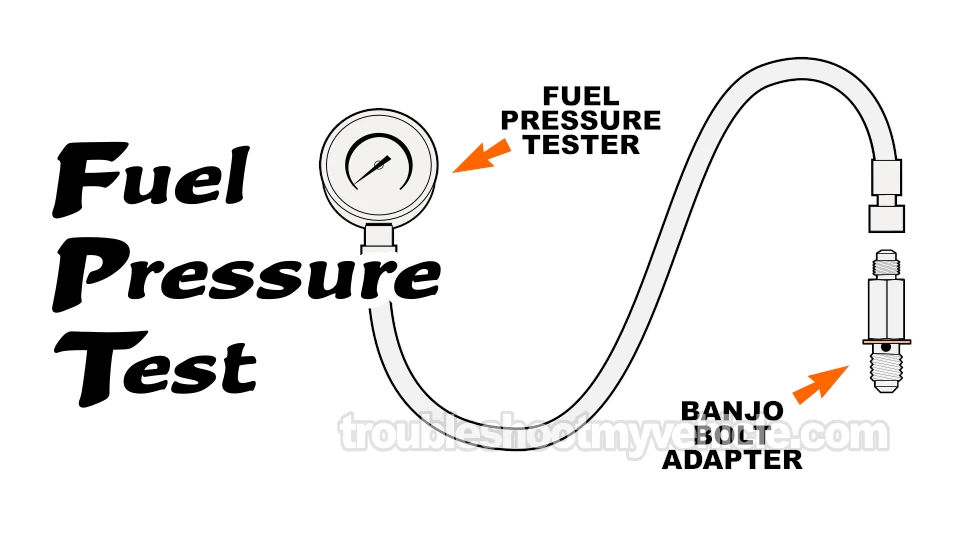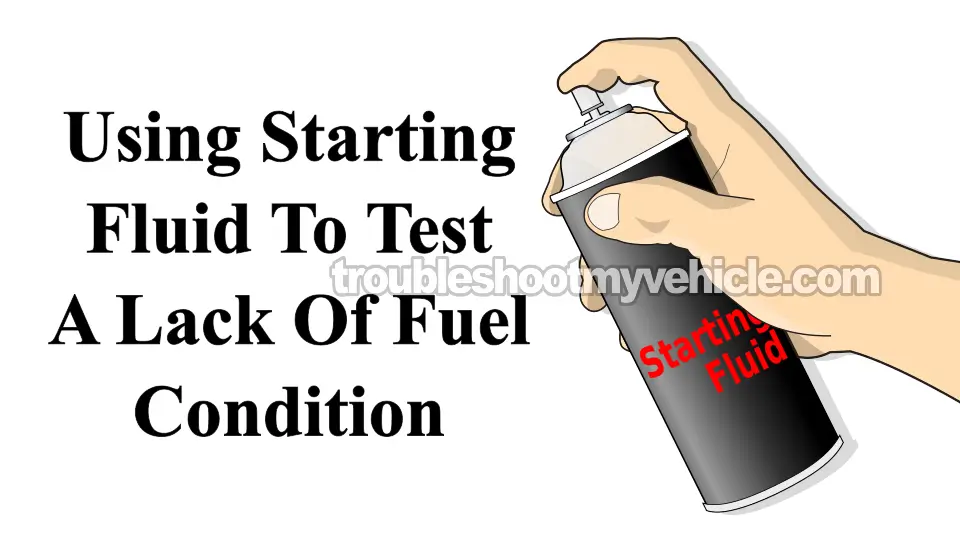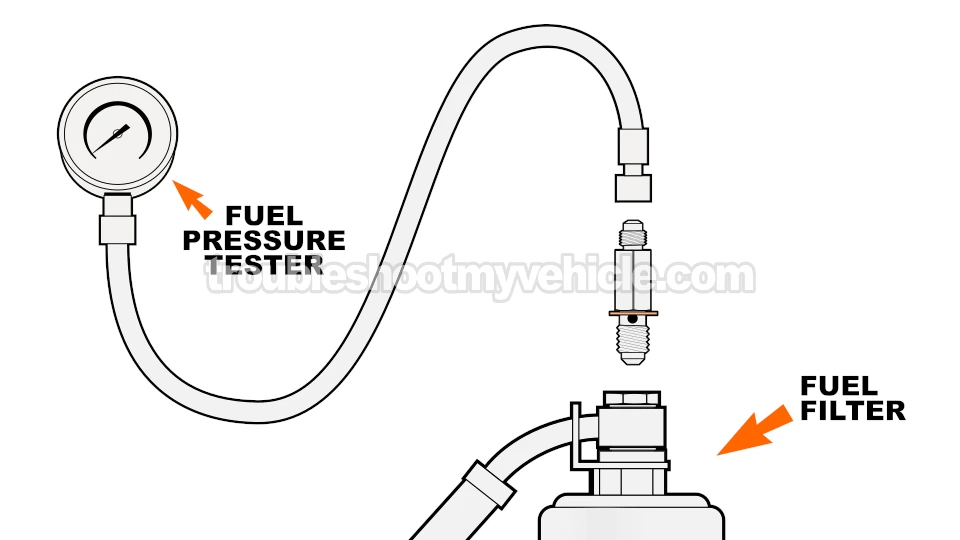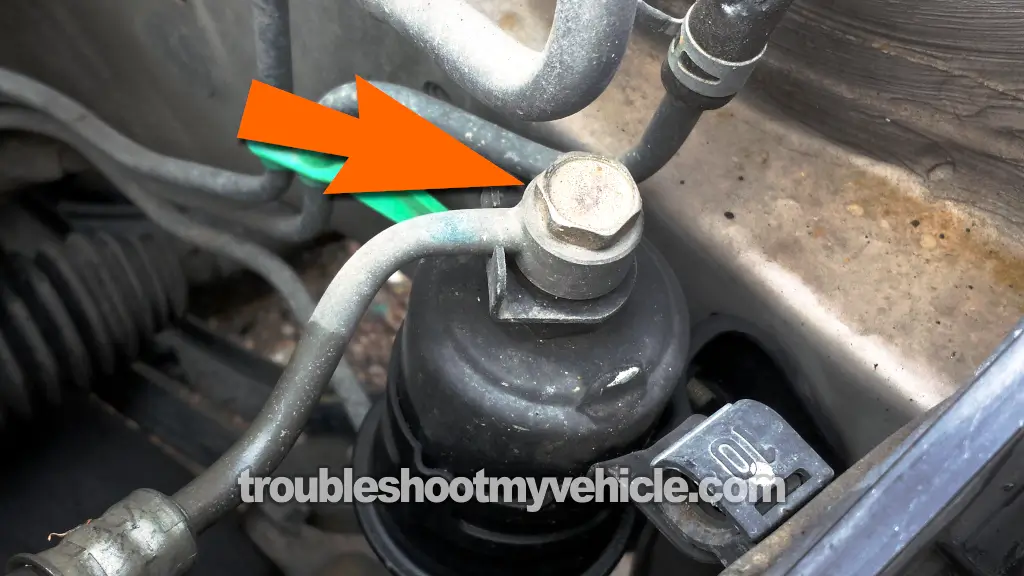
If your Camry won't start or runs poorly and you think the fuel pump might be the culprit, using a fuel pressure test gauge is the best way to figure out what's going on.
The cool thing is that we can easily test the fuel pump on the 1994-1996 3.0L V6 Toyota Camry with a fuel pressure test gauge.
In this tutorial, I'll walk you through how to set up the fuel pressure test gauge, what numbers to look for, and a simple starting fluid trick that can confirm if zero fuel pressure is causing your engine's no-start problem.
Contents of this tutorial:
APPLIES TO: This tutorial applies to the following vehicles:
- 3.0L V6 Toyota Camry: 1994, 1995, 1996.
Fuel Pump Circuit Wiring Diagrams:
- Fuel Pump Circuit Wiring Diagram (1994 3.0L V6 Toyota Camry).
- Fuel Pump Circuit Wiring Diagram (1995-1996 3.0L V6 Toyota Camry).
Toyota Fuel Pump Test Tutorials:
- How To Test The Fuel Pump (1992-1993 3.0L V6 Toyota Camry).
- How To Test The Fuel Pump (1997 3.0L V6 Toyota Camry).
- How To Test The Fuel Pump (1998-2001 3.0L V6 Toyota Camry).
Engine No-Start Diagnostics:
Symptoms Of A Bad Fuel Pump
Fuel pumps often fail in one of two ways:
- Sudden death: The pump simply stops working without warning.
- Gradual decline: The fuel pump continues to function, but with reduced performance. When the engine is under load, engine performance will suffer.
When your 3.0L V6 Toyota Camry's fuel pump fails, you're gonna see:
- Engine won't start: When you turn the key, the engine will turn over, but it won't start up.
- Spark test confirms spark: A spark test confirms that all cylinders are getting spark, which rules out the ignition system as the cause of the engine no-start.
- Fuel injectors activated: A Noid light test shows that your Toyota Camry's fuel injection computer is activating the fuel injectors.
- Zero pressure reading: A zero pressure reading on your fuel pressure test gauge confirms the fuel pump's fried.
- Engine starts briefly with starting fluid: If you spray some starting fluid into the throttle body and then crank the engine, it'll fire up - but just for a few seconds.
If your fuel pump is failing and underperforming, you'll notice one or more of the following symptoms.
- Your car spits out lean air-fuel mixture diagnostic trouble codes.
- The engine stumbles and idles rough.
- It takes forever for the engine to start (starts only after some serious cranking).
- When you hit the gas, the engine lacks the 'oomph' it used to have.
- Under load (like when you're hauling butt down the highway), the engine backfires like crazy through the intake manifold.
A fuel pump pressure test with a fuel pressure gauge is the way to figure out if it (your fuel pump) is causing the no-start problem or affecting your engine's performance.
Where To Buy A Fuel Pressure Test Gauge
You'll need a fuel pressure test gauge to check the fuel pump's performance - you can grab one from an auto parts store or online.
These fuel pressure test kits are great deals, they come with the adapters that'll help you test your 3.0L V6 Toyota Camry (and they've got GM and Ford owners covered too, as long as the fuel injector rails come equipped with Schrader valves).
Disclosure: As an Amazon Associate, I earn from qualifying purchases. If my tutorials help you, using these links is an easy way to support the site at no extra cost to you. Thank you!
NOTE: All of the fuel pump pressure test kits above have the fitting that will connect to your Toyota's fuel system.
TEST 1: Checking Fuel Pressure With A Fuel Pressure Gauge (1994)
OK, we're gonna test your 1994 3.0L V6 Toyota Camry's fuel pump output to figure out if it's completely shot or just starting to fail.
To do this, you'll need to hook up a fuel pressure gauge to the output side of your Camry's fuel filter.
In the instructions, below, I'll walk you thru the whole procedure. The illustration and photo above will also help you identify the connection points.
These are the fuel pressure specifications for the 1994 3.0L V6 Toyota Camry:
| Engine Off and DLC terminals +B and FP jumpered. |
|---|
| 38-44 PSI |
| Engine running and w/out vacuum hose connected to fuel pressure reg. |
|---|
| 38-44 PSI |
| Engine running and w vacuum hose connected to fuel pressure reg. |
|---|
| 31-37 PSI |
NOTE: If you don't have a fuel pressure gauge, take a look at the section: Where To Buy A Fuel Pressure Test Gauge.
OK, these are the test steps:
- 1
Remove the top part of the air filter assembly to access the fuel filter.
- 2
Wrap a shop towel around the fuel filter union bolt (see photo 3 of 4 above).
This shop towel will absorb and keep any fuel from dripping/leaking/spraying on the engine (if there's any residual fuel pressure in the fuel line) as you loosen the bolt. - 3
Remove the fuel filter's union bolt.
NOTE: Careful the union bolt's 2 copper washers don't fall and get lost in the engine compartment. You'll need to re-install them when you get done with the fuel pressure test. - 4
Install the fuel pressure test kit's adapter in place of the union bolt and tighten it (the adapter).
- 5
Locate the diagnostic link connector (DLC) and jumper terminals +B and FP together with a jumper-wire and turn the key On (but don't crank or start the engine). See image 4 of 4.
Jumpering these two DLC terminals will activate the fuel pump when you turn the key to the ON position (without starting the engine).
NOTE: Jumpering these terminals only applies to the 1994 3.0L Toyota Camry. The 1995-1996 V6 Camry's don't have these terminals. - 6
Turn the key to the ON position (but don't crank or start the engine).
NOTE: Check the fuel pressure gauge's adapter connection for fuel leaks. If any leaks are present, turn the key OFF and resolve them to get an accurate fuel pressure output result. - 7
Your fuel pressure gauge should register about between 38-44 PSI fuel pressure if the fuel pump is OK.
NOTE: You can also check the fuel pressure with the engine running, just remove the jumper wire from the Data Link Connector and start the engine. Check the tables above for the indicated fuel pressure specification.
Let's take a look at what your results mean:
CASE 1: The fuel pressure gauge registered 0 PSI. This confirms that the cause of your 3.0L V6 Toyota Camry no-start problem is caused by the fuel pump not sending any fuel to the fuel injectors.
CASE 2: The fuel pressure gauge registered the specified fuel pressure. This test result lets you know that the fuel pump is working and delivering enough fuel to the fuel injectors.
The reason your 3.0L V6 Toyota Camry is not starting is due to another reason. The fuel pump is OK. To further troubleshoot your engine's no start issue, see the following tutorial:
CASE 3: The fuel pressure gauge registered a lower pressure than the specified fuel pressure (but not 0 PSI). This test result lets you know that the fuel pump is weak and failing.
While it's still delivering some fuel, it's not enough to meet the engine's requirements for starting or running properly. The fuel pump needs to be replaced.
TEST 2: Checking Fuel Pressure With A Fuel Pressure Gauge (1995-1996)
OK, we're gonna test your Toyota's fuel pump output to figure out if it's completely shot or just starting to fail.
To do this, you'll need to hook up a fuel pressure gauge to the output side of your Camry's fuel filter.
In the instructions, below, I'll walk you thru the whole procedure. The illustration and photo above will also help you identify the connection points.
These are the fuel pressure specifications for the 1995-1996 3.0L V6 Toyota Camry models:
| Engine running and w/out vacuum hose connected to fuel pressure reg. |
|---|
| 38-44 PSI |
| Engine running and w vacuum hose connected to fuel pressure reg. |
|---|
| 31-37 PSI |
NOTE: If you don't have a fuel pressure gauge, take a look at the section: Where To Buy A Fuel Pressure Test Gauge.
OK, these are the test steps:
- 1
Remove the top part of the air filter assembly to access the fuel filter.
- 2
Wrap a shop towel around the fuel filter union bolt (see photo 3 of 3 above).
This shop towel will absorb and keep any fuel from dripping/leaking/spraying on the engine (if there's any residual fuel pressure in the fuel line) as you loosen the bolt. - 3
Remove the fuel filter's union bolt.
NOTE: Careful the union bolt's 2 copper washers don't fall and get lost in the engine compartment. You'll need to re-install them when you get done with the fuel pressure test. - 4
Install the fuel pressure test kit's adapter in place of the union bolt and tighten it (the adapter).
- 5
Turn the key ON and OFF several times (but don't crank or start the engine) to activate the fuel pump and check for fuel leaks around the fuel gauge adapter.
NOTE: Check the fuel pressure gauge's adapter connection for fuel leaks. If any leaks are present, turn the key OFF and resolve them to get an accurate fuel pressure output result. - 6
Crank and start the engine.
NOTE: If the engine doesn't start, no worries. Crank the engine long enough to get a fuel pressure reading on the gauge. - 7
Your fuel pressure gauge should register:
Engine running (A): About between 33-38 PSI w/ the fuel pressure regulator connected to vacuum (the default mode).
Engine running (B): About 38-44 PSI w/ the fuel pressure disconnected from vacuum.
Engine cranking (engine does not start): About between 38-44 PSI fuel pressure.
Let's take a look at what your results mean:
CASE 1: The fuel pressure gauge registered 0 PSI. This confirms that the cause of your 3.0L V6 Toyota Camry no-start problem is caused by the fuel pump not sending any fuel to the fuel injectors.
CASE 2: The fuel pressure gauge registered the specified fuel pressure. This test result lets you know that the fuel pump is working and delivering enough fuel to the fuel injectors.
The reason your 3.0L V6 Toyota Camry is not starting is due to another reason. The fuel pump is OK. This tutorial will help your further troubleshoot the engine no-start:
CASE 3: The fuel pressure gauge registered a lower pressure than the specified fuel pressure (but not 0 PSI). This test result lets you know that the fuel pump is weak and failing.
While it's still delivering some fuel, it's not enough to meet the engine's requirements for starting or running properly. The fuel pump needs to be replaced.
TEST 3: Using Starting Fluid To Confirm Lack Of Fuel

A tried-and-true diagnostic trick that can help you figure out if the issue lies with the fuel system is using starting fluid to see if it'll get the engine to start and run for a few seconds.
I've used this super simple test plenty of times – it works like a charm! Based on whether the engine starts, you'll be able to confirm if the no-start issue is caused by a lack of fuel from the fuel pump or if you need to keep investigating to find the root cause.
Before running the test, make sure you confirm all six cylinders are getting a spark. Use a spark tester to check each cylinder and get a clear idea of what's going on.
IMPORTANT: When doing this test, don't forget to snap the air intake duct back into place after spraying starting fluid down the throttle bore (even if you don't tighten the air duct hose clamp). This keeps any backfires from exiting the intake manifold plenum while cranking the engine.
Let's get started:
- 1
Remove the intake air duct from the throttle body. You don't have to completely remove it, since you'll have to reconnect it in one of the next steps.
- 2
Open the throttle plate and spray starting fluid down the bore.
As a safety precaution reconnect the air duct after you have sprayed a good squirt of starting fluid (but you don't have to tighten the air duct's hose clamp). - 3
Crank the engine once the air duct is back on and you're clear of the engine compartment.
- 4
You're gonna see one of two things:
1.) The engine will start and run and after a few seconds will die.
2.) The engine won't start at all.
OK, let's find out what your results mean:
CASE 1: The engine started and ran for a few seconds. This test result tells you that the no-start problem is due to a lack of fuel from the fuel pump.
I still suggest double-checking the fuel pump's condition by measuring its fuel pressure output with a gauge to be certain. Go to: TEST 1: Checking Fuel Pressure With A Fuel Pressure Gauge.
CASE 2: The engine did not start, not even momentarily. This usually means that a lack of fuel IS NOT the reason your Camry's engine isn't starting.
In cases like this, I still take the extra step of testing the fuel pressure with a gauge to rule out any issues with the fuel pump. Go to: TEST 1: Checking Fuel Pressure With A Fuel Pressure Gauge.
More 3.0L V6 Toyota Camry Tutorials
You can find a complete list of 3.0L V6 Toyota Camry tutorials and wiring diagrams in this index:
Here's a sample of the tutorials you'll find there:
- How To Test Engine Compression (1992-2006 3.0L V6 Toyota Camry).
- How To Test For A Blown Head Gasket (1992-2006 3.0L V6 Toyota Camry).
- How To Test The MAF Sensor (1994-1996 3.0L V6 Toyota Camry).
- How To Test The TPS (1992-1996 3.0L V6 Toyota Camry).

If this info saved the day, buy me a beer!







